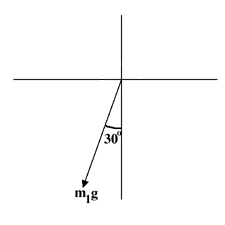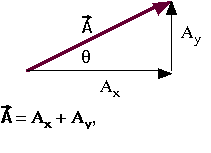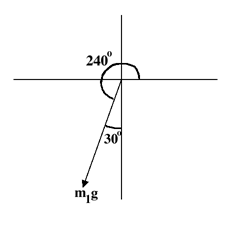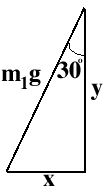In order to solve this problem, we have to find the components of
the force "m1g".
- First, we have to figure out in what direction this force is
oriented. In the initial setup, m1g was
 pointing
straight down along the y axis, the direction that gravity pulls.
In order to simplify the calculation of T and N, we rotated our
perspective 30 degrees clockwise, so that T was aligned with the
new x axis, and N was aligned with the new y axis. This means that
m1g will be oriented 30 degrees in the clockwise
direction from the y axis.
pointing
straight down along the y axis, the direction that gravity pulls.
In order to simplify the calculation of T and N, we rotated our
perspective 30 degrees clockwise, so that T was aligned with the
new x axis, and N was aligned with the new y axis. This means that
m1g will be oriented 30 degrees in the clockwise
direction from the y axis.
- Normally, when determing the components of a vector, we've
used the method:

Ax = A cos q
Ay = A sin q
When we use this method, we measure the angle, q, starting at the x axis and going in the
counter-clockwise direction. We could still use this method to solve
the problem we're dealing with now, by determining the angle of the
m1g vector relative to the x axis:

- Another way to determine the components would be to use some
simple trigonometry. What we have is a right triangle whose
hypotenuse is m1g, and whose legs are the x and y
components of m1g:

Just as we did above, we can determine the x and y components
using the rules for Sine and Cosine in a right triangle:
Sin(30) = x/ m1g
Cos(30) = y/ m1g
Therefore:
x = m1g*Sin(30)
y = m1g*Cos(30)
Remember, however, that these are just the magnitudes. We have to
consider the sense of the problem in order to determine their signs.
Since m1g points in the negative x and negative y
direction, the x and y components must also be negative. Thus, our
final result is:
x = -m1g*Sin(30)
y = -m1g*Cos(30)
 pointing
straight down along the y axis, the direction that gravity pulls.
In order to simplify the calculation of T and N, we rotated our
perspective 30 degrees clockwise, so that T was aligned with the
new x axis, and N was aligned with the new y axis. This means that
m1g will be oriented 30 degrees in the clockwise
direction from the y axis.
pointing
straight down along the y axis, the direction that gravity pulls.
In order to simplify the calculation of T and N, we rotated our
perspective 30 degrees clockwise, so that T was aligned with the
new x axis, and N was aligned with the new y axis. This means that
m1g will be oriented 30 degrees in the clockwise
direction from the y axis.


